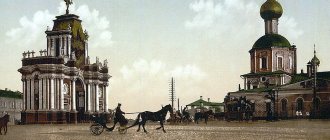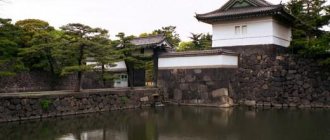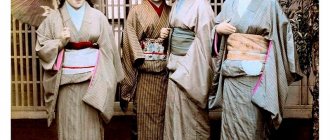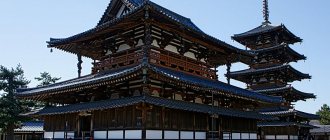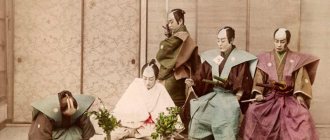Jomon period (Neolithic).
The Jomon period dates back to: 13 thousand years BC - III century. BC. It is named after the type of ceramics with rope (an impression of a rope on clay) ornament (“ jomon ”).
The Jomon culture was widespread throughout the archipelago (from Hokkaido to Ryukyu), its representatives were a sedentary people engaged in gathering, hunting and fishing. The Jomon people had close contacts with the mainland. There are two large settlement areas, the border between which runs approximately at the latitude of modern Tokyo. Agriculture is in its infancy, religious ideas are primitive.
Meiji era (1867-1912)
In 1867-1868, the power of Emperor Meiji was completely restored, and he moved to the new capital of Tokyo. The Meiji era in the history of Japanese development is full of enormous changes. The opening of the “curtain” made it possible not only to trade with most countries, but also to adopt their experiences and discoveries. The economy and military affairs developed at a rapid pace.
The boundaries between social classes were blurred - the government decided to democratize the country. In 1873, a law on freedom to choose religion was passed. Reforms affected the education system, compulsory education was introduced, and the study of Shinto and Confucianism was present in all schools.
To counter European nationalism, Japan paid a lot of attention to the development of the army: compulsory military service was introduced, the fleet was built like the British one, and the army was assembled and modernized like the Prussian one.
To raise the country, specialists were needed. To achieve this, hundreds of students went to study in other countries, and teachers from abroad were invited to teach in educational institutions in Japan.
The year 1889 was marked by the adoption of the first constitution. Despite the emergence of parliament, the independence of the emperor was preserved (he dominated the army, navy, legislative and executive powers).
In 1894-1895, a war broke out between Japan and Korea, the reason for this was disagreement over Korean issues. Japanese troops won, they even captured Taiwan, but the West forced other territories to be given to China.
1904-1905 - the time of the Russian-Japanese War, which broke out due to the interests of China and Manchuria. Japan emerged victorious in the war, thanks to which it received unprecedented fame and respect on the world stage.
Having strengthened its influence over Korea, Japan was able to annex it in 1910.
Yayoi period (Bronze-Iron Age) 3rd century. BC - IV AD
The Yayoi period is named for a specific type of pottery first discovered in the Yayoi-machi area of Tokyo. Main settlement: northern Kyushu Island, Western and Central Japan. A powerful flow (1.2 million people) of immigrants from the south of the Korean Peninsula at this time made up a significant part of the population, a total of 3-6 million people. At this time, three stable cultural and economic zones are formed:
- Hokkaido
- Honshu and northern Kyushu
- South Kyushu and Okinawa.
The time of the appearance of the Proto-Japanese and the Proto-Japanese culture. The transition from hunting-gathering to a productive type of farming. The emergence of “revolutionary” irrigated rice farming, the manufacture and import (from China) of metal agricultural implements. The monetary system is not formed (natural exchange of goods), there is serious social tension in society. Formation of general principles of religious practice (hiding sacred objects), defining some objects as sacred (mirror, sword). China and Korea are establishing themselves as cultural donors. Proto-Japanese culture was finally formed.
Development of the country during the Nara and Heian eras (710-1185)
In 710, the first official capital appeared in Japan - the city of Nara. During the construction of the city, the main reference point was Chinese settlements. In particular, many monasteries were erected here, and the buildings were completely identical in appearance to Chinese houses. This feature largely influenced the future fate of the city. So, in order to avoid increasing the political weight of Buddhist temples, in 1184 they decided to move the capital to the city of Nagaoka, and even later to Heian (it had the status of the main city of Japan for almost 1000 years).
The Nara era in Japanese history was marked by the fact that Chinese influence on Japanese culture weakened somewhat. If before this the main language was Chinese, now the Japanese have created their own alphabet - “kana”.
As for political power, it was concentrated in the hands of the Fujiwara clan for a long time.
The “Taika reforms”, adopted somewhat earlier, have already had an impact on the life and way of life of the people of Japan. The main essence of these reforms was to increase taxes on peasants. Along with this, the aristocracy and monasteries, on the contrary, were exempt from paying taxes. The result is the strengthening of the influence of large landowners and the people remaining below the poverty line.
At the beginning of the 12th century, Fujiwara's power was limited. At the same time, a struggle for power unfolded between two clans: Minamoto and Taira. As a result of the uprising in 1159, the Taira clan was able to retain the reins of power in its hands, whose dominance continued until 1178. The death of Taira Kiyomore again plunged the country into a power struggle, which resulted in the Genpei War (1180-1185).
Kofun (mound) period - IV - VI centuries.
The Kofun period is named for the numerous mound-type burial structures. In connection with the formation of the tribal state of Yamato, the second half of this period may be called the “Yamato period” . The main thing is the period of formation of statehood and centralization, which, among other things, served as an impetus for the organization of large-scale irrigation works and the active development of writing. During this period, the spread of Buddhism began, which soon assumed the role of a national ideology. The economy is highly differentiated and practically divided into “guilds”, if not “castes”: farmers, potters, fishermen, salt makers, blacksmiths. Military leaders undertake military campaigns in Korea.
State formation
Japan of those times can only be judged by Chinese chronicles, since the Japanese did not have their own written language. The Chinese called them “wa” and mentioned that they lived in about a hundred states, a third of which maintained contacts with their country. In the 5th century, Japanese agriculture was enriched by the cultivation of:
- nettles for making fabric - ramie,
- cereal crops,
- spices,
- cannabis,
- tangerines.
Rice cultivation in Japan.
Engraving Silkworm breeding and the production of silk and linen fabrics, as well as the extraction of pearls, cinnabar and lapis lazuli, developed.
The most powerful ancient Japanese state was Yamatai. This country entered into the system of Asian political relations on China's terms: it paid tribute to it and agreed with the supremacy of the Chinese emperor. He, in turn, assisted in politics the rulers who fulfilled these conditions, and allowed them to have trade relations with the Middle Kingdom.
In the 4th century, China became involved in civil strife; Silla, Goguryeo and Pekje appeared on the Korean Peninsula, expressing a desire to unify Korea, and the state formation of Yamato began the struggle for the unification of Nippon. From the 3rd to the 6th centuries, it was customary here to bury wealthy citizens in kofuns - mounds made of earth, which is why this period is also called Kofun.
Kofun period mound
In Yamato, a system of clans and titles in the executive branch developed, since the state was a federation. The heads of clans received titles from the leader in accordance with their status. The state pursued an active foreign policy. Koreans and Chinese settled here and brought with them new information and skills that contributed to the development of:
- jewelry making,
- engineering,
- hieroglyphic writing,
- medical skills,
- new technology in the manufacture of ceramic tableware.
from Korean Bekje associated with Buddhism came to Nippon The new doctrine causes controversy, leading to a fight between two clans: Soga and Mononobe. The Soga clan advocated the adoption of Buddhism and won an irreconcilable struggle.
Asuka period (592-710).
The Asuka period is named after the location of the residences of the Yamato kings in the Asuka region (near the modern cities of Nara and Kyoto) and is characterized not only by the final formation of what would now be called a “rule of law state,” but also by increasingly intensifying political confrontation. The establishment of the power of the emperor, the formation of the institution of bureaucracy, the proclamation of state ownership of land, the establishment of an allotment system of land use.
The closest contacts with China, which by this time had finally formed a strongly centralized empire, the beginning of the Taika reform (in 646), which aimed to transform Yamato into a “civilized” (in the Chinese manner) state. The attempt to conquer Korea ends in complete failure, as a result, the armed forces were reformed, a regular army and conscription were introduced. The capital of the country is Fujiwara , the rulers are Emperors Jitto, Mommu and Gemmei.
Development of statehood
This event ends the prehistoric development of Japan - the Genshi era, and begins a new one - Kodai, relating to the history of ancient Japan. Her first period, Asuka, is associated with the name of Prince Shotoku, who headed the government under Empress Suiko. On the territory of modern Nara there was the village of Asuka, near which all political and cultural life was concentrated, and it gave the name to the period.
Prince Shotoku (c. 574 - c. 622) - Japanese prince regent, reformer and politician of the Asuka period
The prince tried to create a monarchy in the country. He created a system of titles and ranks of twelve levels and moral and ethical rules for officials - the “Constitution of Seventeen Articles.” Buddhist teachings became the official religion under him. Traditional beliefs - Shinto - also flourish, and the state takes care of their coexistence.
In the 7th century, Emperor Kotoku, who came to power, took up the “great transformations” - Taika. The first step of the Taika reforms was to declare all lands and its people the property of the state. The following innovations were adopted by subsequent emperors Tenji and Tenmu:
- general army duty
- strengthening borders with castles and fortress walls,
- posting sentries on the island of Kyushu,
- bringing legislation into order according to the model of the Celestial Empire,
- compilation of the chronicles of Nippon.
The capital moves successively to Otsu, Fujiwara and Heijō (modern Nara). And Japan begins to be called Nippon. During the Nara period, new laws were adopted and they began to issue their own money. Provinces, counties and rural areas make up the structure of the country.
State of Nippon during the Nara era
For the allocated land plots, the population paid the state with harvests, fabrics, and products of their own production, and also had to work for free for two months a year. All people began to be divided by status into free and dependent (ryomin and semmin).
But soon the land fund was exhausted due to population growth, so Emperor Shomu was allowed to privatize virgin lands. This law contributed to the development of economic relations. Nobles and Buddhist monasteries began to accumulate land property.
The culture of the time was marked by copying Korean and Chinese artistic traditions. Over sixty Buddhist monasteries were built, among which are considered cultural monuments
- Todai-ji,
- Tosedai-ji,
- Kofuku-ji.
Poetry flourished in literature, its anthologies were compiled, the most famous of which is Manyoshu, which collected about four and a half thousand poems written over a hundred years.
Todai-ji is the temple of Buddha Vairocana, the Great Buddha. Completed in 745
When Heian (later Kyoto) became the capital in the 8th century, relations between the Buddhist clergy and aristocrats became conflicting. Military service is now performed not by peasants, but by noble people. The Fujiwara family enjoys significant influence at court, women from which become imperial wives.
Since there was no regular army, samurai detachments from those who had already served their mandatory term appeared to guard and defend the lands. They were led by noble people. The most famous are representatives of the Minamoto and Taira clans.
Emperors Go-Sanjo and then Shirakawa managed to remove the Fujiwara clan from power through cunning political moves. The result was “insei”—the rule of retired emperors. The samurai were separated into an independent class. Their power and authority grew day by day.
During the Heian period, the Buddhist sects Tendai and Shingon appeared, calling for solitude and obtaining enlightenment through the study of sacred texts and prayer. Relations with China weaken, and the flourishing of a distinctive Japanese culture begins, marked by the appearance of:
- Yamato-e painting,
- national alphabet kana,
- literary works based on it,
- palaces with new trends in architecture,
- court culture of Kokufu.
Heian period. Engraving
Nara period (710-794).
The Nara period is named for the location of Japan's first permanent capital at Nara , located in the center of the mainland. The population of the capital is up to 200,000 people. The name of the country was changed to “ Japan ” (“Nihon” - “where the sun rises”). The active construction of a centralized state in accordance with legislative codes, in connection with which this period (and the beginning of the next) is often called “ritsure kokka ” (“state [based] on laws”). Strict legalized social ranking with a strong desire to preserve family ties. Widespread use of writing based on the educational system. The appearance of written monuments - the mythological and chronicle collections “Kojiki” and “Nihon Seki”.
The army serves only the internal needs of the state; the number of its units in the capital is about 5,000 people. Active and systematic construction of an extensive network of excellent roads, on which 400 postal yards are organized with distances between them of 16 km. Thus, the problem of movement was effectively solved - in just a week, moving from the capital, it was possible to reach any of the most remote points of the country. Oddly enough, attention is paid to purely overland methods of travel. Water transport is not developed at all and is not in demand.
Kodaly (VI century - 1185)
The Asuka period (538–710) is the second sub-period of the Yamato era. During this era, Buddhism penetrated and spread into Japan, a centralized Chinese-style state appeared, the first set of laws, “ritsuryo,” was created, and Japanese culture flourished under the influence of mainland ideas.
The Nara period (710–794) began with the restoration of the capital in the city of Heijō-kyō and ended with its transfer to the city of Heian-kyō. A feature of the era is the accelerated Sinicization of Japan, in particular, the first historical chronicles were created and Buddhism and poetry flourished.
The Heian period (794-1185) began with the transfer of the state capital from Nara to the city of Heian-kyo (modern Kyoto) and ended with the victory of the Minamoto house over the Taira house at the naval battle of Dannoura.
Heian period (794-1185).
The Heian period is named after the location of the new capital - Heian (literally “capital of peace and tranquility”, modern Kyoto , which formally remained the capital, i.e., the imperial residence right up to 1868). Marked by trends in the decline of state power associated with the loss of the state monopoly on land, the collapse of the allotment system and the formation of shoen - privately owned estates. The emergence of a brilliant aristocratic culture, the creation of numerous prose and poetic works. Political dominance of the Fujiwara family (hence the end of this period is sometimes called the “Fujiwara period” ).
Middle Ages
In the Middle Ages, the time of the samurai began in Nippon. A power struggle begins between their families, and the Taira win. The defeated Minamoto clan formed opposition to them. The fighting continued and the Minamoto later overthrew the Taira rule.
In the 12th century, the institution of the shogunate was formed, and dual power developed in medieval Japan: the Kyoto emperor and the shogun in Kamakura, who represented the interests of the samurai. Samurai and ordinary people begin to become interested in Buddhism. Among them, the Jodo sect, which preached Amidism, was popular. The following schools of Japanese Buddhism are also becoming famous:
- Jodo-shinshu,
- Nichiren-shu,
- Soto-Xu,
- Rinzai.
While the first school paid great attention to sinners, the followers of the second focused on the Lotus Sutra, and the last two preached Zen Buddhism. The shogunate fell into decline over time, and the ruler Go-Daigu attempted to restore the monarchy (Kemmu restoration).
Shogunate period in Japan
The attempt was unsuccessful and ended in a split in the imperial power and a war between the clans. In the 14th century, the next shogunate, Muromachi, emerged, and then the third, Yoshimitsu.
The following changes are taking place in the economy, social sphere and culture:
- appearance of water wheels,
- using animals as draft power,
- planting new crops in gardening,
- cotton breeding,
- improvement of forging and foundry metallurgy,
- holding trade fairs,
- creating communities of carriers and moneylenders,
- formation of communities of burghers for protection from samurai,
- evolution of self-government,
- development of theater but,
- design of rock gardens,
- use of tatami,
- development of the arts of ikebana and tea ceremony, etc.
Muromachi period, 1392-1568 (Ashikaga shogunate).
The Muromachi period is named after the location of the headquarters of the Ashikaga shoguns in Muromachi (Kyoto region). Often divided into two subperiods: the southern and northern dynasties (“ nambokucho” , two kingdoms 1336-1392), when there were two parallel and competing imperial courts, and the “period of the warring provinces” ( “sengoku jidai” , 1467-1392 1568). Constant feudal internecine wars (especially in the second half of this period). At the end of the period - the growth of cities, accompanied by the development of urban secular culture. First contacts with Europeans.
Political history of Japan up to the year 700
Political history of the Japanese islands to 700 AD. can be characterized by identifying periods corresponding to a certain time:
- Jomomon period (translated as clay product). Before 300 AD there was no political component as such in Japan. In those distant times, the population was engaged in hunting, gathering and fishing.
- Yayoi period. This period of time lasted until 250 AD. and was distinguished by the emergence of agriculture, the unification of some countries, and the emergence of blacksmithing. According to ancient sources, in those days the priestess Pimiko acted as the ruler of the country.
- Yamato period. In 400 A.D. With the help of the power held by the Yamato tribe, Japan was unified. The political center was located in Yamato province, but often moved to other countries.
Finished works on a similar topic
- Coursework Political history of Japan 450 rub.
- Abstract Political history of Japan 280 rub.
- Test paper Political history of Japan 230 rub.
Receive completed work or specialist advice on your educational project Find out the cost
Edo period, 1603-1867 (Tokugawa shogunate).
The Edo period is named for the location of the headquarters of the Tokugawa shoguns in Edo (modern Tokyo ). The founder of this shogunate, Tokugawa Ieyasu , brought the country out of a permanent state of civil war and united it under his leadership. The expulsion of Europeans and the prohibition of Christianity were accompanied by a voluntary “closure” of the country, when all contact with the outside world was reduced to a minimum.
Rapid growth of cities, development of urban culture, economy, sharp increase in population. The total regulation of the life of all segments of the population finally formed the type of mentality that we call “Japanese”.
LECTURE 3. JAPAN IN MODERN TIMES (XVII - early XX centuries).
The appearance of Europeans contributed to the strengthening of trading capital, the improvement of military affairs, aggravated internecine wars and led to the danger of not only the split of Japan, as mentioned above, but also its subjugation to the Europeans.
Internecine wars and peasant uprisings created a real threat to the very existence of the feudal lords; for the normal functioning of commercial capital it was necessary to eliminate feudal barriers; the threat of foreign enslavement of Japan was brewing. All this caused an objective need to unite the country.
The initiators of the unification were the feudal lords of the central part of the island. Honshu - Oda Nobunaga, Toyotomi Hideyoshi and Tokugawa Ieyasu.
2. The struggle for the unification of Japan. Oda Nobunaga came from Owari Province (modern Aichi Prefecture). He was the second son of a minor feudal lord, and his father settled him away from the family, building a small castle in Nagoya. After the death of his father in 1551, seventeen-year-old Nobunaga showed considerable cunning, seizing other people's lands, sparing neither relatives, in-laws, nor neighbors. Od's military successes were facilitated by the arming of his squad with firearms. In 1573, he overthrew the last shogun from the house of Ashikaga, who by that time had completely lost political influence. To provide the troops with food, he introduced a special rice tax, which remained until the end of the feudal period.
Oda subjugated more than half of the territory and abolished outposts in the conquered cities, abolished internal customs taxes, which, in turn, met fierce resistance from the feudal lords and court aristocracy, who lost the main source of their income. He stimulated the development of trade by tightening penalties for robbery and created “free markets.”
Having abolished the private measures of liquid and granular bodies, Oda introduced a unified Kyoto measure equal to 1.8 liters. A fixed exchange rate was established and the use of rice as a medium of exchange was prohibited. Oda began to issue gold coins, but there was still not enough gold and silver for mass production of money, although he captured the silver mines of Ikuno.
By hook or by crook, expanding his possessions, brutally suppressing peasant uprisings, Oda Nobunaga laid the foundation for the “shogun-princely” (bakuhan)
to the state. However, his rise forced many feudal lords who had previously been at war with each other to unite in the fight against him, and in addition, strife began in the camp of Oda himself. In 1582, being surrounded by enemy troops in one of the Kyoto temples, Oda committed suicide.
The work of unifying the country was continued by Toyotomi Hideyoshi, who came from peasants and came to the fore in the service of Oda.
Hideyoshi's domestic policy was similar to Oda's. In the conquered territories, Hideyoshi measured the lands and classified them as “directly controlled possessions,” which yielded 2 million koku of rice (1 koku - about 160 kg). The “directly controlled possessions” included the cities of Osaka, Kyoto, Nara, Ominato (north of Honshu) and the cities of Nagasaki and Ha-kata associated with foreign trade.
Hideyoshi paid special attention to agrarian policy, the essence of which was the attachment of peasants to the land and the strengthening of the feudal structure (“secondary enslavement of the peasants”). Hideyoshi, for the first time nationwide, conducted a census, where peasants were divided into two groups: tax-paying peasants - the “main” peasants, who included not only wealthy peasants, but also less wealthy ones in order to increase the size of the tax-paying population, and landless peasants who were “outside” census”, not attached to the land, which were allowed to move.
In 1568, a decree was issued on the tax rate and the attachment of peasants to the land, according to which the peasant had the right to no more than 1/3 of the harvest, and the lord - to no less than 2/3. The census approved the abolition of fiefdoms, the strengthening of the rural community and the presence of developed vassal relations.
Coming from a peasant background, Hideyoshi brutally suppressed peasant uprisings. The enslavement of the peasants was accompanied by the confiscation of their weapons. According to the 1588 decree on “sword hunting”, peasants were prohibited from possessing swords, daggers, guns and other weapons. Three years later, a new decree formalized social differences. A three-class division of society was established into samurai (si),
peasants
(no)
and townspeople
(simin).
The latter consisted of merchants and artisans, who were not yet differentiated. In 1597, five- and ten-dvorki were introduced as a lower administrative unit, and a system of mutual responsibility was established. A year later, in order to increase the taxation of peasants, units of land area were reduced: tan from 0.12 hectares was reduced to 0.1 hectares, and those from 1.2 hectares to 1 hectare while maintaining the old taxation rates, as a result of which the tax burden of peasants increased by approximately by 30%. Hideyoshi confirmed the transfer of rent from monetary calculation to a product basis (rice), which was practically carried out by his predecessor.
From the very beginning of his career, Hideyoshi nurtured a dream of expanding boundaries. Back in 1583, he demanded payment of tribute from Korea, and in 1591 he sought recognition of her vassal obligations. The Korean authorities refused both times. In May 1592, a 137,000-strong Japanese army landed in Korea and marched on Seoul. However, the Korean campaign ended in failure and weakened the southwestern feudal lords and large merchants who supported Hideyoshi, since they were connected to the foreign market. The position of the princes of North-Eastern and Central Japan, who suffered less from the hardships of the war, strengthened. The role of trading capital operating in the domestic market also increased.
The death of Hideyoshi in 1598 nullified the efforts of the first unifiers. The internecine struggle broke out with renewed vigor between the third unifier Tokugawa Ieyasu and his opponents, who grouped around Hideyoshi’s son, Hideyori.
Having been defeated in the Battle of Sekigahara (on the east coast of Lake Biwa) in 1600, Hideyori and his supporters settled in Osaka, which became the center of the opposition for 15 years. At the Battle of Sekigahara, Tokugawa first used “invisible men” (ninjas) as spies.
In 1603, Ieyasu Tokugawa took the title of shogun and, having founded the Shogunate (1603-1867) with its capital in Edo (modern Tokyo), marked the beginning of the military-feudal dictatorship of the most influential house of that time. In fact, Tokugawa and his followers removed the imperial house from power and political life. However, they continued to emphasize his religious authority and constantly claimed that they had received the sanction of power from the emperor himself (the mikado).
3. Japan at the beginning of the 17th century. Under the first Tokugawa shoguns, Japan began to transform into a single state, although complete unification of the country was never achieved. The political situation was stabilized by suppressing the opposition of the princes. At the beginning of the 17th century. some of them who converted to Christianity (the Tokugawa opposition counted on Western help) were executed along with their families (Takeda, Minai, Kumachai). A number of princes, mainly from the southwest, had their lands confiscated. Others were resettled to new lands. As a sign of gratitude to the allies, the land area was increased.
Thus, the Tokugawa managed to concentrate their possessions in the center of the island. Honshu. One mass of their lands was located in the Edo region, and another around the city of Osaka, while the lands of their supporters were concentrated along the most important strategic and economic artery - the Edo-Osaka road.
The ruling princes differed in the degree of their wealth, which was calculated by the annual income of rice. The total rice income of Japan at the beginning of the 17th century was determined at 11 million koku (1 koku - 180.4 liters). Of this amount, 4 million koku belonged to the Tokugawa house. Only a small group of the richest feudal lords (only 16 feudal princes had an income of over ZOO thousand koku of rice each) enjoyed some independence, had a significant number of samurai vassals, and sometimes even minted their own
Taking into account these dangers, the Tokugawa proceeded in their policy, building it in such a way as to: firstly, keep the peasantry and the urban lower classes in check and not allow any relaxation that could give them the slightest opportunity to organize for the fight; secondly, to control the relationship of feudal princes among themselves, preventing the strengthening of any of them and thereby maintaining a leadership position for the Tokugawa clan; thirdly, keep a watchful eye on foreigners and keep the doors of Japan locked.
One of the most important components of Tokugawa’s domestic policy was the “closure of the country.” The reason was the widespread penetration of Europeans, the spread of Christianity and the threat of Japan becoming a colony (which had already happened in a similar scenario in the Philippines). Back at the end of the 16th century, the Japanese were greatly outraged by the practice of Portuguese and Spanish missionaries who exported people from Japan to sell them into slavery.
However, the first shogun of the Tokugawa dynasty, Ieyasu, initially did not take decisive measures against the Europeans. At this time he was interested in the supply of firearms and in organizing shipyards for the construction of large ships. The partners here were the Dutch and the English who arrived in Japan in 1600. The shogun granted the Dutch East India Company the right to trade on much more favorable terms than the compromised Spaniards and Portuguese.
But soon the Shogunate began to express dissatisfaction with the trade policy of the Dutch, who appropriated most of the income from foreign trade. Following this, a conspiracy of the Spaniards and Portuguese was revealed, aimed not only at expelling the British and Dutch, but also at the actual subjugation of the regime with the help of the princes of the southern part of the country who had converted to Christianity - the most implacable opponents of the Tokugawa clan. It should be noted that the southern princes accepted the new religion almost exclusively for commercial and political separatist reasons. They sought to take advantage of the benefits of overseas trade, and then, relying on their European allies, who supplied them with weapons, oppose the shogunate. All this prompted the Tokugawa to conduct punitive expeditions and promulgate a decree (1614) completely banning Christianity.
Tokugawa Iemitsu, who became shogun in 1623, took up arms against Christians with even greater zeal than his predecessor. The apogee of the confrontation was the events in Shimabara (near Nagasaki). Repressions and punitive expeditions of government troops caused a peasant uprising, the real cause of which was not religious persecution, but feudal oppression: under the pretext of eradicating Christian false teaching, shogun officials committed lawlessness in the conquered region. When the uprising was suppressed after a three-month siege and the fall of their last stronghold - the fortress at Shimabara - 38 thousand Christian rebels were killed. This became one of the largest massacres of Christians in history. It is characteristic that the Dutch, in order to gain political capital, provided powerful military support to the shogun.
With the suppression of the Shimabara uprising , the Shogunate made the final decision to “close” Japan to foreigners and isolate the country from all external influence. In 1638, Yemi'tsu issued a decree on the expulsion of all Portuguese from Japan (the Spaniards were expelled back in 1634). Any foreign ship that landed on the Japanese shores was subject to immediate destruction, and its crew - the death penalty.
An exception was made only for the Dutch. They were left with a trading post on the small island of Deshima, where trade took place under the watchful supervision of government officials. Merchants were required to give a special undertaking to refrain from openly displaying their religious beliefs and not to enter into any relations with the Japanese other than purely business ones, which were regulated in detail by the rules of trade. As for Japanese citizens, back in 1636 they were prohibited, under pain of death, from leaving their homeland and building large ships for long voyages. As a result of these measures, the country was closed to Europeans.
4. The situation of the peasantry. The shogunal authorities paid special attention to control over the peasantry. To this end, the government practiced extensive intervention in the life and economy of peasants, trying to completely subordinate them to its administrative and political control.
Basically, the internal policy of the authorities in relation to the agricultural population was as follows: a consistent increase in tax oppression and widespread interference in the economy and life of the peasant community through a complex system of administrative regulations. These regulations applied to all aspects of peasant life. First of all, they were forbidden to have (keep or hide) weapons. Peasants were forbidden to eat rice (their main food at that time was millet), which was declared a luxury. They were forbidden to wear silk or linen clothes; they could only sew clothes from cotton fabric. Later shoguns further strengthened this regulation: the law precisely defined the cut and color of fabric. The type of house for a peasant family was officially defined, and the use of carpets and other “luxury items” to decorate them was prohibited. Traditional entertainment such as theatrical performances, wrestling, etc. was cancelled; It was not even allowed to visit each other. And all ceremonies, such as weddings or funerals, had to be performed with “modesty.” In the event of a crop failure or some natural disaster, all these prohibitions became even more stringent.
An essential feature of the Tokugawa regime was its desire to universally introduce a system of hostage or mutual responsibility to ensure uninterrupted receipt of taxes and exercise strict control of the authorities. Government officials appointed a village headman and his assistants to be in charge of a specific group of households (twenty-five or fifty depending on local conditions), and all duties were imposed on the community as a whole - for collective responsibility for their implementation. The headman and his assistants were usually selected from wealthy peasants. Many of them, circumventing the existing restrictions of the law, exploited their poor fellow community members, lending them rice to pay rent, and then taking away their crops and even land. The bulk of the peasants cultivated plots ranging from 0.36 to 0.45 hectares, which yielded an average harvest of 640-800 kg of rice. The dominant form of feudal rent was quitrent in kind, and, thanks to this, there was the possibility for rich peasants of some accumulation and enslavement of the poor.
Thus, in the village, oppressed by heavy feudal oppression and doomed to political lawlessness, internal processes took place that undermined the principle of the immutability of feudal orders, which formed the basis of the feudal regime and all its policies.
5. Economic and social structure of cities. The position of other segments of the population that did not belong to the ruling feudal class was legally no less powerless than the position of the peasantry. But in fact, the economic strength of the trading bourgeoisie ensured its growing political influence.
The centers of the trading bourgeoisie were large cities, primarily Edo and Osaka. In the capital of Edo, large trading firms were most dependent on the government. This was both the source of their strength and weakness. Strength, because these trading firms established strong ties with the capital administration and became a necessary supplier and creditor for it, and weakness was that, dependent on the government, the Hedron bourgeoisie was not distinguished by either initiative or desire to expand its political rights.
The picture was different in the city of Osaka, which had preserved some of the traditions of the free city since the 16th century. In modern times, during the XVII-XVIII centuries. Osaka became a stronghold of a more independent merchant class, ready to defend its rights and privileges. Osaka soon became the main center of commercial activity in the country. The most powerful merchant associations and the main warehouses of goods were located there. They belonged not only to merchants, but also to feudal princes, who brought all the marketable products of their estates to Osaka: rice, silk, lacquerware, paper, etc. Although rice remained the main measure of value at this time, money also became widespread. The princes, as well as ordinary samurai, sought to convert part of their income into money. Because of this, the operations of Osaka rice buyers - wholesalers who handed money to the nobles for the rice they took from the peasants - became especially important. By this they saved the noble samurai from all sorts of troubles that were humiliating from the point of view of the feudal code of honor.
By financing the klyas against future rice revenues, Osaka wholesalers exerted enormous economic pressure on local feudal lords. And, although, as already mentioned, the Tokugawa laws provided for the fight against luxury and formally prohibited all townspeople (including merchants) from wearing silk clothes, gold and silver jewelry, even building houses more than 2 floors, but in reality it was different: wealth and luxury goods were increasingly concentrated in the hands of large merchants. Government officials did not even try to prevent this.
An important privilege of merchants, preserved from the previous historical period, was the right to unite in guilds, recognized by the government. Sometimes these guilds were formed mechanically from among individuals of the same profession, such as a guild organization of artisans. But the most influential were merchant organizations, consisting of merchants who traded the same types of goods or operated in the same area. And if in relation to craft guilds the government exercised cruel forms of control and intervention, then in relation to influential merchant guilds it allowed a number of benefits and, in any case, was wary of entering into conflict with organized merchants, on whom the receipt of credit depended.
The position of artisans and other townspeople was incomparably worse than the position of the merchants. Craftsmen were organized into special workshops (dza),
built on the principles of monopoly of production, heredity of craft and internal hierarchical structure (master - journeyman - apprentice). The government strictly regulated the activities of workshops and imposed heavy taxes on artisans.
In relation to them, the regulations were in full force, without exceptions. Government officials considered themselves complete masters over the townspeople and allowed themselves any lawlessness. It is therefore not surprising that the urban poor constantly expressed their dissatisfaction with the Tokugawa regime and joined the peasant protests against the shogunate. For one XVII century. There were 463 uprisings, the causes of which were the abuses of officials and samurai.
The townspeople also included a layer of intellectuals: teachers, doctors, artists. They were mainly from the feudal class. At this time, the ancient term “ronin” began to be applied to them.
During the Tokugawa period, this began to be called samurai who had lost their vassal connection with their princes and essentially lost their class affiliation. Back in 1615, Ieyasu Tokugawa finally suppressed the resistance of Hideyori and his supporters, occupying the city of Osaka. With the physical destruction of opponents, confiscation of principalities, execution and transfer of princes to new lands, many of their vassals were deprived of their livelihoods and turned into wandering people (i.e. ronins). During the Osaka Company, about 100 thousand ronin were destroyed, but there were still about ZOO thousand of them throughout the country. These lower strata of the samurai class were ready to take part in any anti-government protest. They took part in peasant and urban uprisings, became pirates, and some of them rushed to the cities and over time acquired a profession. Thus, the number of new groups of the middle strata of urban society, the predecessors of the intelligentsia, grew. The ronins who became part of this urban stratum were initially opponents of the shogunate. In addition, their main customer and client was the urban bourgeoisie. Therefore, the ronins supported the claims of the bourgeoisie to an independent political role in society, self-government of cities, etc.
At the same time, the Tokugawa also had their own feudal intelligentsia, which was the conductor of government ideology. The government did not trust the Buddhist clergy. The military and economic power of Buddhist monasteries was undermined, although Buddhism continued to be the most widespread religion in the country. Confucian dogmas were adopted as the basis of the official government ideology, instilling in the people the need for cruel self-restraint and fanatical adherence to traditional orders. To disseminate them, appropriately trained people were required, and the Shogunate needed such personnel, who were also used to fight the Buddhist clergy. Therefore, a center of Confucian learning was formed in Edo, uniting a group of philosophers, writers and historians. Their tasks included the ideological substantiation of the foundations of the Tokugawa regime and therefore they enjoyed special patronage among the authorities.
6. Feudal structure of the shogunate. The Tokugawa divided all the nobility into several categories. Kyoto nobility, i.e. The imperial family and their closest relatives were allocated to a special group - “kuge”.
The kuge nominally constituted the highest rank among the feudal nobility. The shoguns were distrustful of the apparent obedience and political indifference of the imperial entourage. Tokugawa legislation paid special attention to the regulation of the relationship between the emperor and his entourage and everyone around him. The emperor should not have “condescended” to communicate with his subjects, especially princes. Any attempt by the princes to establish contact with the emperor was punishable by death and confiscation of land holdings. In fact, the court and aristocracy - kuge - were isolated from Japanese society.
All other feudal clans were called "buke"
(military houses).
The ruling princes (daimyo), in turn, were divided into three categories: the first belonged to the house of the shogun and was called Shinhan;
the second -
fudai
- included princely families that had long been associated with the Tokugawa house, dependent on it militarily or economically and therefore were its main support (they occupied the posts of council members, governors, etc.);
and, finally, the third category - tozama
- consisted of sovereign princes who were independent of the Tokugawa house and considered themselves feudal families equal to it. The Tozama enjoyed enormous, almost unlimited power in their domains, like, for example, the princes of Shimazu in Satsuma or the princes of Mori in Choshu. The Shogunate saw them as its ill-wishers, possible rivals, and tried in every possible way to undermine their power and influence, using the old policy of “divide and conquer.” There were also regulations regarding them. They could not hold government positions. Their possessions, located, as a rule, far from the capital (this largely explained their certain independence) were surrounded by the shogun through a special settlement system, fudai-daimyo. Castles were built at all important strategic points in order to paralyze the actions of the tozama daimyo in the event of the formation of anti-shogun opposition.
An exceptional measure of pressure on the tozama category (as on all daimyo) was the hostage system (san-kinkodai). All feudal princes were obliged to visit Edo every year, at the court of the shogun, and live there with their retinue and family, with the splendor and pomp prescribed by the ceremony. At the same time, “according to custom,” they had to regularly present the shogun with rich gifts along with gold and silver coins, which, in fact, was a disguised form of tribute. After a year at the shogun's court, the daimyo left, but had to leave their wife and children as hostages in Edo. Thus, any disobedience to the shogun entailed reprisals, including against hostages.
Yet, despite the despotic nature of the Tokugawa power, the position of the princes was not so constrained that they always sought to overthrow the shogun at any cost. Within the limits of his feudal domain, the prince was an almost unlimited master. They did not pay special taxes to the shogunate, apart from the so-called gifts to the shoguns. True, the government announced that it retained (on behalf of the emperor) supreme control over all land holdings and therefore had the right to take away the possessions of all feudal princes, redistribute them and reward them with new ones. However, in practice this right of supreme power was rarely used.
Formally, samurai also belonged to buke ,
which was a military class that had a monopoly on carrying weapons.
Under Tokugawa, an influential layer emerged in samurai - hatamoto
(literally “under the banner”). The hatamoto samurai were the shogun's immediate and closest vassals and formed the main support of the Tokugawa regime. They occupied the position of serving nobility, supervising the peasants and other disadvantaged strata in the Tokugawa domains, and were also in charge of collecting taxes.
Following them came the bulk of the samurai, who were not subject to the shogun, but were vassals of appanage princes. They did not have land, but received a salary in rice, without bearing any specific duties, only forming a permanent retinue of their daimyo overlords. The financial situation of ordinary samurai worsened significantly under the Tokugawa regime. The main occupation of the feudal nobility has always been war. Code of Samurai Honor (Bushido)
strictly forbade samurai to engage in anything other than military affairs. But under the Tokugawa regime, war ceased to be an everyday occurrence. On the contrary, the government’s goal was to avoid external wars as much as possible and stop internal feudal strife. The samurai detachments of princes found real practical use only in suppressing local peasant uprisings. Thus, a clear contradiction arose between the traditions, habits, morality of militant samurai and the situation of relative internal peace established in Japan under the rule of the Tokugawa. The daimyo no longer needed to support numerous samurai. The rice ration did not satisfy their needs; it was not enough for a prosperous life. Therefore, lower-ranking samurai, along with ronin, sought new means of subsistence in various ways. Over time, the government had to note with alarm the significant increase in the number of homeless and declassed samurai. The future danger was that they would increase the already numerous ranks of those dissatisfied with the prevailing order.
To prevent an open explosion of discontent and suppress indignation at the initial stage, the Shogunate created an extremely extensive and strong police apparatus that supervised various social forces: the peasants and the urban lower classes (including the ronin); for the princes of Tozama-daimyo; for disgruntled samurai. However, these measures could not delay, much less prevent, the crisis of the country's feudal economy.
7. Economic development. Peasant uprisings. The Tokugawa regime finally took shape under the third shogun, Tokugawa Iemitsu (1623-1651), around the middle of the 17th century. Despite the largely reactionary nature of the Toku-Gawa order, until the end of the 17th and beginning of the 18th centuries, a certain rise in productive forces was observed in the country. This was explained by the fact that after continuous internecine wars of the 16th century, which catastrophically ruined the peasantry, Japan entered a period of long-term internal peace.
There was some improvement in agricultural technology, an expansion of acreage, and an increase in productivity, as a result of which Japan's national income increased significantly (from 11 million koku of rice at the beginning of the 17th century to 26 million koku at the end of it) and the population increased.
The development of productive forces was reflected in the success of crafts and a significant expansion of domestic trade. However, all this was accompanied by such processes as the development of commodity-money relations, the growth of differentiation of the peasantry and the strengthening of trade-usurious capital, as well as the village elite associated with it. This sharply intensified the internal contradictions of the country's feudal economy. The bulk of the peasant population, under the influence of the penetration of commodity-money relations into the villages, quickly went bankrupt.
This was accompanied by the following phenomena at the top of Japanese society. The period of apparent prosperity, called in Japanese history the “genroku era” (1688-1703), was marked by the flourishing of feudal culture, the patronage of music, painting, and theater by the shogunate. The princes competed to imitate the brilliance, luxury and extravagance of the shoguns' court.
The nobility spent huge amounts of money on entertainment. This led to the enrichment of the urban bourgeoisie and an increase in the debt of samurai and princes, who increasingly turned to merchants and moneylenders for loans. At the same time, the exploitation of the bulk of the already disadvantaged peasantry intensified, which in addition paid for the wastefulness of the nobles.
And if in the 17th and early 18th centuries. Japan experienced some growth in productive forces, but in the subsequent period clear signs of decline are revealed. Decomposition of the feudal system in the 18th century. manifested itself in a slowdown and then a cessation of growth in rice production. The gross harvest dropped to the level of the 17th century. The size of the cultivated land area remained unchanged. Agricultural profitability fell due to declining yields. The peasant population was ruined under the burden of unbearable exploitation.
The cessation of growth in the peasant population became the second distinctive feature of this time. According to government censuses, in 1726 the population of Japan was estimated at 29 million people, in 1750 - 27 million, in 1804 - 26 million and in 1846 (i.e. 22 years before the fall of the Tokugawa regime) - 27 million. If we take into account some growth in the urban population, then there is an undeniable decline in the rural population.
The reason for the population decline lay in the enormous mortality rate from famine and epidemics. In 1730-1740, the population decreased by 800 thousand people as a result of famine, and in the 1780s - by 1 million, and not a single samurai died of hunger.
In these harsh conditions, peasants widely practiced infanticide. The spread of this terrible custom is proven by the preservation in the language of numerous terms, the original meaning of which is the killing of newborns (for example, “mobiki” - “weeding”).
⇐ Previous4Next ⇒
Recommended pages:
Meiji period (1868-1911).
The Meiji period is named after the motto of the reign of Emperor Mutsuhito - “bright reign”. Unable to resist the growing military-political pressure from the Western powers, Japan was forced to carry out large-scale reforms aimed at creating a modern industrial state. The reforms, which were revolutionary in nature, were clothed in the ideological shell of a return to traditional values, to the legal order of antiquity, that is, the “restoration” of the power of the emperor, which had been relegated to the background under the shoguns.
Rapid industrial development, widespread borrowing of the achievements of Western civilization, which, however, managed to preserve national identity. The beginning of external expansion.
New time
In the 18th-19th centuries, the authority of the shogunate was shaken, and imperial power was restored with the help of Emperor Meiji. The five hundred year reign of the shoguns is over. Since then, Japan has become a world-class industrial power.
The country experienced ups and downs, periods of militaristic sentiments and expansionism. Now Japan is heading towards liberal democracy and is one of the most influential countries in the world with a high level of technology and economic development.
World War II and post-war period
A policy of aggressive militarism leads to the occupation of Manchuria in 1931, followed by the bombing of Shanghai. In 1937, the Second Sino-Japanese War began and lasted until 1945. Only defeat in World War II and the signing of unconditional surrender by the emperor put an end to Japan's militaristic aspirations.
The war-ravaged country, which survived two atomic bombings and was occupied by the Americans, also lost part of its territory. Under the leadership of the American General MacArthur, reform of the political and economic system of the state began. In 1947, a new Constitution was adopted that prohibited Japan from having its own armed forces.
The Peace Treaty signed in 1952 ended the American occupation. Gradually, the country began to establish contacts with its former opponents - the USSR and China. In 1972, the island of Okinawa, previously also occupied by the United States, was returned.
Gradually, the country's economy began to recover, and in the 80s of the 20th century, a period of prosperity for the state began. Despite the political and economic crisis that followed, Japan is still one of the strongest players on the world stage.

